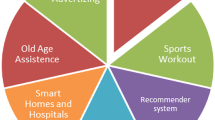Abstract
Human Activity Recognition (HAR) has earned a lot of importance in recent years due to its applications in various domains including smart healthcare, entertainment, surveillance applications and so on. Due to easy portability and privacy, inertial sensing based HAR has gained potential research interests. The accelerometer and gyroscope sensors detect the body acceleration and angular acceleration respectively which are essentially time series signals. However, 1D time-series signal patterns are found to be insufficient for recognition of some of the daily activities. Existing HAR works are mostly focused on the recognition of a given bunch of activities rather than finding out what kind of data dimensions and classifiers work best to identify different kind of activities. In this paper, we propose a two-phase deep learning classification approach for activity recognition that handles the problem hierarchically. We have shown that signals for different groups of activities need different preprocessing measures in order to extract effective high dimensional features from them in a later phase. CNNs with different dimensions have been utilized accordingly for automatic extraction of robust features. A combination of temporal pattern analysis and spatial pattern analysis is applied through the proposed approach. SVM has been used to divide the bunch of activities in two classes, static and dynamic. The proposed framework achieves overall accuracy of 95.72% for all activities of the UCI HAR dataset when the training data and the test data are collected from different user subsets. Thus, the results indicate that this approach can be applied to classify data from new set of users as well.











Similar content being viewed by others
References
Subasi A, Khateeb K, Brahimi T, Sarirete A (2020) Human activity recognition using machine learning methods in a smart healthcare environment. In: Innovation in health informatics, Elsevier, pp 123–144
Sachdeva A, Mohan A (2021) A novel approach to human–computer interaction using hand gesture recognition. In: Data Science and Security, Springer, pp 7–15
Babiker M, Khalifa OO, Htike KK, Hassan A, Zaharadeen M (2017) Automated daily human activity recognition for video surveillance using neural network. In: 2017 IEEE 4th international conference on smart instrumentation, measurement and application (ICSIMA), IEEE, pp 1–5
Nandy A, Saha J, Chowdhury C, Singh KP (2019) Detailed human activity recognition using wearable sensor and smartphones. In: 2019 International Conference on Opto-Electronics and Applied Optics (Optronix), pp 1–6. https://doi.org/10.1109/OPTRONIX.2019.8862427
Saha J, Chowdhury C, Biswas S (2018) Two phase ensemble classifier for smartphone based human activity recognition independent of hardware configuration and usage behaviour. Microsyst Technol 24(6):2737–2752
Deng G, Cahill L (1993) An adaptive gaussian filter for noise reduction and edge detection. In: 1993 IEEE conference record nuclear science symposium and medical imaging conference, IEEE, pp 1615–1619
Jiang W, Yin Z (2015) Human activity recognition using wearable sensors by deep convolutional neural networks. In: Proceedings of the 23rd ACM international conference on Multimedia, pp 1307–1310
Ragab MG, Abdulkadir SJ, Aziz N (2020) Random search one dimensional cnn for human activity recognition. In: 2020 International conference on computational intelligence (ICCI), IEEE, pp 86–91
Ronao CA, Cho SB (2016) Human activity recognition with smartphone sensors using deep learning neural networks. Expert Syst Appl 59:235–244
Nandy A, Saha J, Chowdhury C (2020) Novel features for intensive human activity recognition based on wearable and smartphone sensors. Microsyst Technol 26:1889–1903
Ahmad Z, Khan NM (2019) Multidomain multimodal fusion for human action recognition using inertial sensors. In: 2019 IEEE Fifth international conference on multimedia big data (BigMM), IEEE, pp 429–434
Wan S, Qi L, Xu X, Tong C, Gu Z (2020) Deep learning models for real-time human activity recognition with smartphones. Mob Netw Appl 25(2):743–755
Fazli M, Kowsari K, Gharavi E, Barnes L, Doryab A (2020) Hhar-net: hierarchical human activity recognition using neural networks. 2010.16052
Cho H, Yoon SM (2018) Divide and conquer-based 1d cnn human activity recognition using test data sharpening. Sensors 18(4):1055
Ignatov A (2018) Real-time human activity recognition from accelerometer data using convolutional neural networks. Appl Soft Comput 62:915–922. https://doi.org/10.1016/j.asoc.2017.09.027
Yang J (2009) Toward physical activity diary: motion recognition using simple acceleration features with mobile phones. Association for Computing Machinery, New York, NY, USA, p 1–10. https://doi.org/10.1145/1631040.1631042
Winograd S (1978) On computing the discrete fourier transform. Math Comput 32(141):175–199
Nussbaumer HJ (1981) The fast fourier transform. In: Fast fourier transform and convolution algorithms, Springer, pp 80–111
LeCun Y, Bengio Y, Hinton G (2015) Deep learning. Nature 521:436–444
Anguita D, Ghio A, Oneto L, Parra X, Reyes-Ortiz JL (2013) A public domain dataset for human activity recognition using smartphones. European Symposium on Artificial Neural Networks, Computational Intelligence and Machine Learning, ESANN 2013, 437–442
Kohavi R (1995) A study of cross-validation and bootstrap for accuracy estimation and model selection. In: Proceedings of the 14th international joint conference on artificial intelligence - vol 2. Morgan Kaufmann Publishers Inc., IJCAI’95, pp 1137—-1143
Author information
Authors and Affiliations
Corresponding author
Additional information
Publisher's Note
Springer Nature remains neutral with regard to jurisdictional claims in published maps and institutional affiliations.
Rights and permissions
Springer Nature or its licensor (e.g. a society or other partner) holds exclusive rights to this article under a publishing agreement with the author(s) or other rightsholder(s); author self-archiving of the accepted manuscript version of this article is solely governed by the terms of such publishing agreement and applicable law.
About this article
Cite this article
Mallik, M., Sarkar, G. & Chowdhury, C. A Deep Learning Framework for Smartphone Based Human Activity Recognition. Mobile Netw Appl (2023). https://doi.org/10.1007/s11036-023-02117-7
Accepted:
Published:
DOI: https://doi.org/10.1007/s11036-023-02117-7




